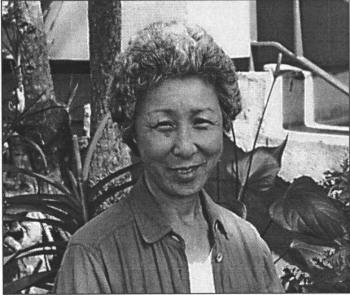June Mitsuko Shigemasa

Tsunamis Remembered: Oral Histories of Survivors and Observers in Hawai‘i
Life history interviews with individuals who witnessed and survived tsunamis-particularly the 1946 and 1960 disasters on the Big Island of Hawai'i. Thirty individuals-mostly residents of Hilo and Laupahoehoe-recall their experiences before; during, and after the 1946 and 1960 tsunamis which were arguably the most destructive natural disasters in modem Hawaiian history.
June Mitsuko Odachi Shigemasa was born September 27, 1935 in the Shinmachi district of Hilo, Hawai'i. Her parents, Kinzaemon Odachi and Kameki Tsuno Odachi, were immigrants from Japan who came to Hawai'i as Tenri-kyo [a Buddhist sect] ministers. Shigemasa, her parents, and siblings lived in a two-story house on the temple grounds. She was attending nearby Waiakea Kai School when World War II broke out. Following the Pearl Harbor attack, Kinzaemon Odachi was arrested by the FBI and interned at Santa Fe, New Mexico. Like most Buddhist ministers, Kinzaemon Odachi was a leader in the Hilo Japanese community and was suspected of being an enemy alien. After his departure from Hawai'i, Mrs. Odachi was given the option of being closer to her husband on the Mainland, though not at the same camp. The family left Hawai'i and traveled to Jerome, Arkansas, where they lived in an internment camp for Japanese Americans. They later were moved to Gila River, Arizona internment camp. Shigemasa, her mother, and siblings spent the duration of the war at Gila River. Tragically, Kinzaemon Odachi became critically ill and died in Santa Fe. His wife traveled to Santa Fe and brought his ashes back to Arizona. Shigemasa recounted these harrowing tales in her 'lwalani Street home on land acquired via a low-interest loan offered to survivors displaced by the 1960 tsunami. She and her husband operate a small retailing business from their home. They raised two daughters and have two grandchildren. Shigemasa and her family returned to Hilo in November of 1945 and resumed life in Shinmachi. Five months later, trauma struck the family again. On Aprill, 1946, the tsunami crashed into their house and carried it into the Wailoa River. Shigemasa, her mother, and siblings managed to escape from the house and swim to safety. The family was housed in former U.S. Army barracks located where Ho'olulu Park is today. Her mother was forced to go on welfare, while Shigemasa and her siblings worked as housekeepers. Life eventually returned to normal. Shigemasa graduated from Hilo High School in 1954. In 1956 she married Susumu Shigemasa. The couple was living on Kumu Street, in the Kimiville section near downtown Hilo, when another tsunami hit Hilo in the early-morning hours of May 23, 1960. Shigemasa, her husband, and young daughter were at home when water from the tsunami fllled the house. They eventually escaped from the house through a window and swam up to the roof. Susumu was able to locate a board on which they climbed and drifted to safety.
Scope and Content Note
The daughter of a Tenrikyo minister recalls her Shinmachi church and home, parents, and childhood activities. She describes her father's and family's separate World War II internment in Mainland camps and her father's subsequent death. She tells of returning to Shinmachi and being caught in the 1946 tidal wave, which hit her house. She also describes her mother's healing ministry. In the 1960 tsunami, now married, she, her husband, and daughter narrowly escaped from the water flooding their Kumu Street home. She talks of buying their new house, made possible by a low-interest loan to those who lost homes in the disaster. She closes with her appreciation of life and thoughts on parenting.
Program Note:
This interview is part of the Center for Oral History's project Tsunamis Remembered: Oral Histories of Survivors and Observers in Hawai‘i. Interviews from this project are available in the Center's ScholarSpace open access repository.
The Center for Oral History (COH), in the Department of Ethnic Studies at the University of Hawaiʻi at Mānoa, collects, documents, preserves and highlights the recollections of Native Hawaiians and the multi-ethnic people of Hawaiʻi. It produces oral histories and interpretive historical materials about lifeways, key historic events, social movements and Hawaiʻi’s role in the globalizing world, for the widest possible use.
Please Note: The oral histories in this collection are protected by copyright and have been created for educational, research and personal use as described by the Fair Use Doctrine in the U.S. Copyright law. Please reach out Voices@noaa.gov to let us know how these interviews are being used in your research, project, exhibit, etc. The Voices staff can help provide other useful resources related to your inquiry.
The NOAA mission is to understand and predict changes in climate, weather, oceans, and coasts, to share that knowledge and information with others, and to conserve and manage coastal and marine ecosystems and resources. The Voices Oral History Archives offers public access to a wide range of accounts, including historical materials that are products of their particular times, and may contain offensive language or negative stereotypes.
Voices Oral History Archives does not verify the accuracy of materials submitted to us. The opinions expressed in the interviews are those of the interviewee only. The interviews here have been made available to the public only after the interviewer has confirmed that they have obtained consent.
